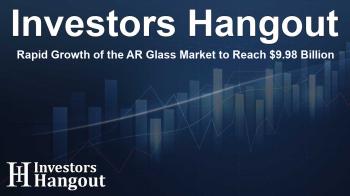Rapid Growth of the AR Glass Market to Reach $9.98 Billion

Future of Augmented Reality Glasses and Market Insights
The augmented reality (AR) glass market is emerging as a transformative force within the technology landscape, with an impressive projected value of USD 9.98 billion by 2030. Analysts anticipate a robust compound annual growth rate (CAGR) of 59.0% from 2025 to 2030, showcasing the increasing relevance of AR glasses in various sectors. This growth is spurred by the escalating adoption of AR technology in industrial and enterprise applications and the continuous advancements in display and sensor capabilities.
Key Drivers of AR Glass Adoption
The surge in the AR glass market can be attributed to several key drivers. First and foremost is the growing demand for hands-free operational capabilities, which enhances productivity across diverse sectors such as healthcare, logistics, and defense. With real-time collaboration brought to the fore, these glasses facilitate remote assistance and immersive visualization, integrating seamlessly into critical workflows.
Moreover, significant investments by top tech companies exemplify their commitment to this technology. These investments fuel the continuous miniaturization of hardware, alongside the pivotal integration of artificial intelligence (AI). As a result, AR glasses are evolving into smarter, more adaptable devices that cater to a myriad of industries.
Technological Advancements and 5G Impact
The expansion of 5G technology plays a crucial role in the AR glass market, providing the needed bandwidth and low latency for effective real-time applications. This infrastructure supports the rising demand for improved worker safety and optimized training methods, enhancing the overall efficacy of AR technologies.
Tethered AR Segment: The Growth Leader
In examining market segments, tethered AR systems are predicted to experience the fastest growth during the forecast period. Unlike standalone devices, tethered AR glasses connect to external computing units to manage complex data processing. This allows manufacturers to create lighter, more comfortable glasses without sacrificing performance.
The cost-effectiveness and compatibility of tethered AR with existing enterprise systems further enhance its appeal. Companies looking to adopt AR solutions can implement tethered glasses with relative ease, leveraging current devices without the need for extensive investments in new standalone models. Major players such as XReal, Rokid, and Seiko Epson Corporation are at the forefront, delivering innovative tethered solutions that cater to both industrial and commercial requirements.
Enterprise Adoption of AR Glasses
The enterprise and industrial segment is set to capture the largest market share, driven by industries such as manufacturing, automotive, and energy. The integration of AR glasses allows businesses to streamline operations, provide remote support, and enhance training for critical tasks, particularly in challenging environments.
As companies undergo digital transformations, the reliance on AR glasses for operational efficiency becomes increasingly significant. Integration with existing software platforms and IoT systems fosters data visualization and precision workflows, making companies like Microsoft and RealWear key players in establishing ruggedized devices for industrial applications.
Regional Growth Trends in the AR Market
North America is expected to retain a significant share of the AR glass market, owing to its advanced digital ecosystem and strong presence of AR technology firms. The region's early adoption of AR technologies and government initiatives in sectors such as military and logistics bolster this growth. The capabilities of robust 5G networks, coupled with continuous R&D advancements, reinforce the area's dominance in AR integration.
Competitive Landscape and Future Outlook
The competitive landscape for AR glasses features key players including XReal, Magic Leap, and Microsoft, all pursuing diverse strategies such as product innovations and strategic collaborations to bolster their market positions. The ongoing shift towards AR applications signifies a growing trend toward immersive experiences across various industries.
As the AR glass market continues to evolve, organizations are well-positioned to leverage this technology for enhanced productivity and better operational outcomes. The future looks bright for augmented reality as businesses increasingly recognize its potential within the global tech landscape.
Frequently Asked Questions
What is the projected value of the AR glass market by 2030?
The AR glass market is projected to reach USD 9.98 billion by 2030.
What are the key drivers for AR glass adoption?
Key drivers include the need for hands-free operation, technological advancements, and the integration of AI.
Which segment of AR glasses is expected to grow the fastest?
The tethered AR segment is expected to register the highest growth rate between 2025 and 2030.
How does 5G technology influence the AR glass market?
5G technology enhances the performance of AR applications through increased bandwidth and reduced latency.
Which industries are adopting AR glasses the most?
Industries such as manufacturing, healthcare, logistics, and defense are leading in AR glasses adoption.
About The Author
Contact Ryan Hughes privately here. Or send an email with ATTN: Ryan Hughes as the subject to contact@investorshangout.com.
About Investors Hangout
Investors Hangout is a leading online stock forum for financial discussion and learning, offering a wide range of free tools and resources. It draws in traders of all levels, who exchange market knowledge, investigate trading tactics, and keep an eye on industry developments in real time. Featuring financial articles, stock message boards, quotes, charts, company profiles, and live news updates. Through cooperative learning and a wealth of informational resources, it helps users from novices creating their first portfolios to experts honing their techniques. Join Investors Hangout today: https://investorshangout.com/
The content of this article is based on factual, publicly available information and does not represent legal, financial, or investment advice. Investors Hangout does not offer financial advice, and the author is not a licensed financial advisor. Consult a qualified advisor before making any financial or investment decisions based on this article. This article should not be considered advice to purchase, sell, or hold any securities or other investments. If any of the material provided here is inaccurate, please contact us for corrections.

